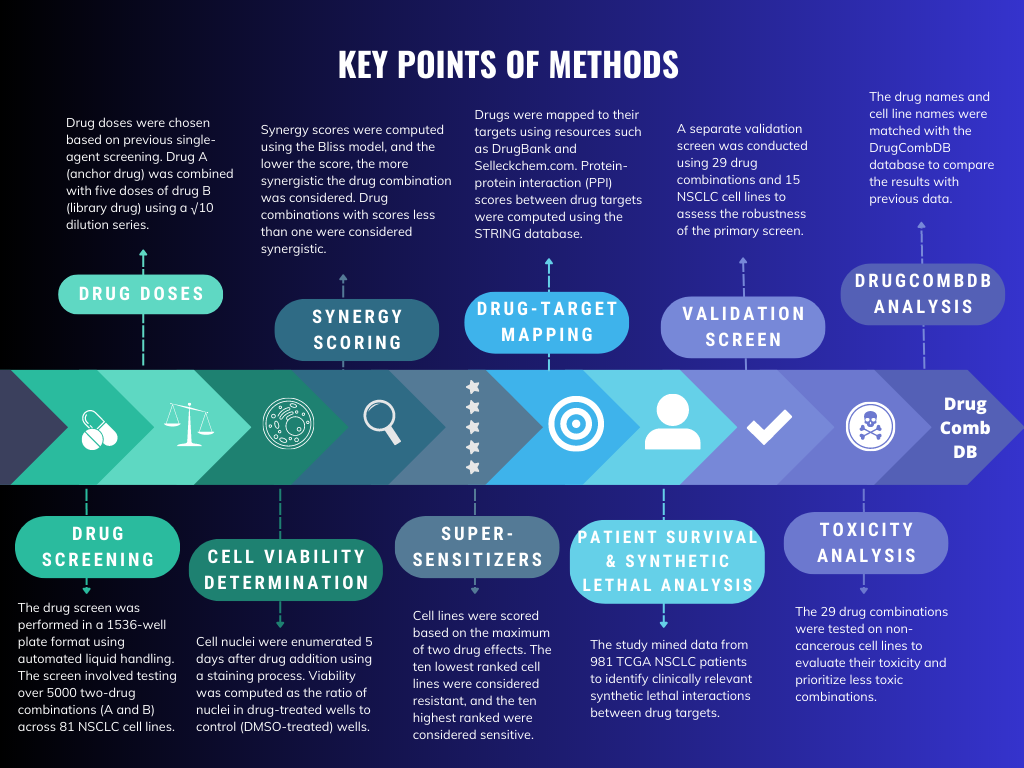
Promising Drugs for Lung Cancer
By harnessing a vast new source of data, researchers at the National Cancer Institute (NCI) have identified targeted drug combinations that show promise in the fight against lung cancer. This discovery opens new avenues for more effective and personalized treatments for lung cancer patients. Let's take a closer look at the details of this remarkable breakthrough.
Vast Data Set enables Combinations with Synergy and More Effective Drugs
In a recent study, researchers from the National Cancer Institute (NCI) have created a vast data resource that may hold the key to more effective treatments for lung cancer. The study, published in Nature Communications, focused on identifying drug combinations with synergy, where the combined drugs work much better against cancer than individually. By testing over 5,000 drug combinations on 81 non-small cell lung cancer (NSCLC) cell lines, the researchers discovered several promising combinations that showed potential for improved therapeutic outcomes.
Synergistic Combinations in Lung Cancer Treatment
The researchers embarked on a comprehensive drug screening initiative to investigate the potential of various drug combinations in combating NSCLC. They systematically tested pairs of 21 "anchor" drugs, which were selected based on their relevance to NSCLC treatment and preclinical studies. These anchor drugs were combined with 242 "library" drugs that encompassed various targeted therapeutic classes used against cancer.
Key Findings
The study identified several drug combinations that exhibited strong synergy against NSCLC cell lines. Notably, combinations involving CHK1 inhibitors and WEE1 inhibitors demonstrated high effectiveness in many cell lines. Additionally, the study unveiled synergistic potentials in combinations involving PARP inhibitors, decitabine, zebularine, MEK inhibitors, and PI3K pathway-targeting drugs.
Key findings of the study include:
Polypharmacology significantly influences the synergistic potential of drug combinations.
Certain drugs showed more synergistic effects when combined with specific partners.
The validation screen confirmed the robustness of the original screen's findings and the impact of polypharmacology on synergistic potential.
Synergistic combinations tend to involve drugs that target proteins with close functional interactions in the protein-protein interaction network.
Synthetic lethality, where the combination is effective while individual drugs are not, was observed in a small fraction of drug combinations.
The mutational status of cancer driver genes did not significantly influence synergism.
The study identified drug combinations with potential clinical relevance and improved patient survival based on gene expression and copy-number data analysis.
Overall, the study provides valuable insights into the complexity and potential of drug combinations in cancer treatment, and it highlights the importance of considering polypharmacology when developing combination therapies.
Insights from Validation and Genomic Analysis
To validate their findings, the researchers collaborated with the National Center for Advancing Translational Sciences (NCATS) and cross-referenced their results with genomic and transcriptomic data from the Cancer Genome Atlas (TCGA). The validation screens confirmed the robustness of the primary data and highlighted the potential clinical relevance of the identified drug combinations.

Impact of Polypharmacology on Combination Outcome
One significant observation from the study was the influence of compound polypharmacology on combination outcome. Polypharmacology refers to a drug's ability to interact with multiple targets in the body. The researchers found that drugs with similar interactions and those targeting multiple pathways were more likely to yield synergistic effects in combination.
Promising Avenues for Lung Cancer Treatment
The dataset generated from this study represents a valuable resource for the scientific community, providing a strong foundation for further research. The findings open up exciting possibilities for developing targeted drug combinations that may offer new treatment options for lung cancer patients. Future research may involve testing these promising combinations in animal models and ultimately in clinical trials to bring these innovative therapies closer to patients in need.
Conclusion
 In this manuscript, we describe the outcome of a very large combinatorial drug screen surveying over 5000 two drug combinations across 81 NSCLC highly characterized cell lines, some of which are further tested in an additional validation screen.
In this manuscript, we describe the outcome of a very large combinatorial drug screen surveying over 5000 two drug combinations across 81 NSCLC highly characterized cell lines, some of which are further tested in an additional validation screen.
This pioneering research by NCI sheds light on the potential of drug combinations in treating lung cancer. By identifying synergistic drug pairs and considering polypharmacology, the study lays the groundwork for more effective and less toxic therapies. As scientists and clinicians explore these findings further, there is hope that these combinations could revolutionize lung cancer treatment and improve patient outcomes.
Do you also want to benefit from efficient, high-quality data analysis to discover effective drug compounds, explore biomarkers, or stratify patients? We're happy to help! Check out our solutions.